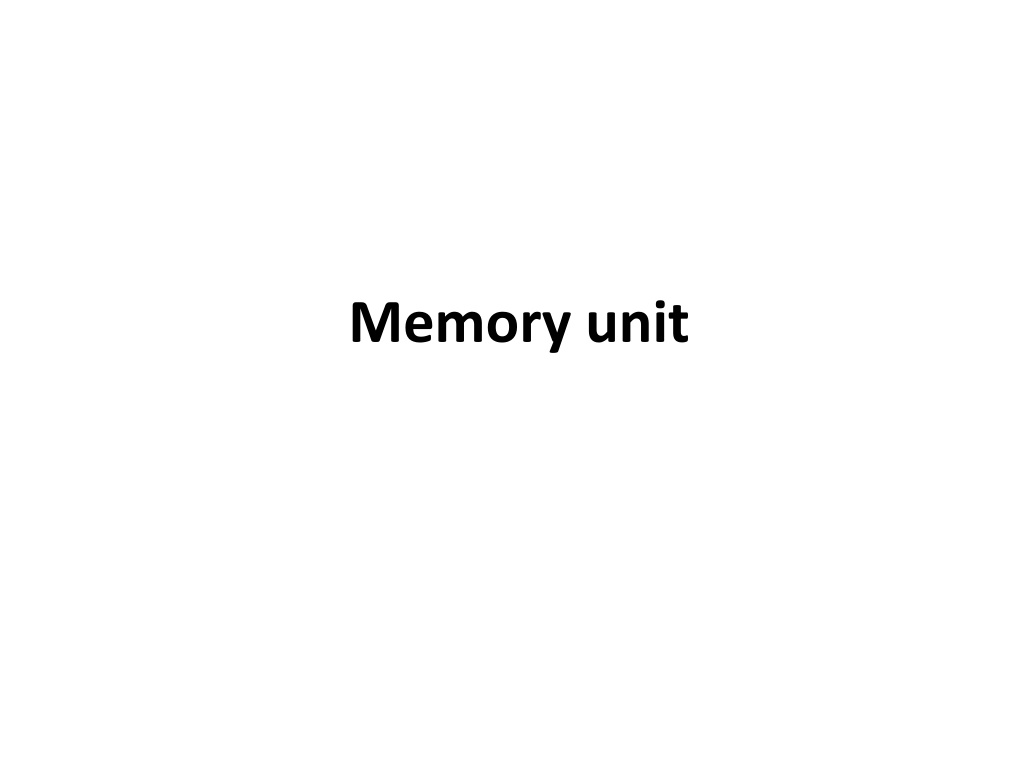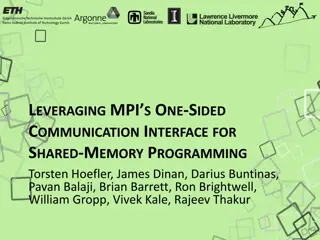Understanding Memory Units in Computing
Memory units are essential components in computing devices that store binary information in words, allowing for fast and efficient data retrieval. They consist of storage cells, circuits, and address selection lines for communication. Random Access Memory (RAM) enables quick access to data, while Read Only Memory (ROM) stores permanent information. Memory capacity is measured in bytes, and communication with memory involves data input/output lines, address selection lines, and control lines.
Download Presentation

Please find below an Image/Link to download the presentation.
The content on the website is provided AS IS for your information and personal use only. It may not be sold, licensed, or shared on other websites without obtaining consent from the author. Download presentation by click this link. If you encounter any issues during the download, it is possible that the publisher has removed the file from their server.
E N D
Presentation Transcript
Memory unit A memory unit is a collection of storage cells, together with associated circuits needed to transfer information into and out of a device. The architecture of memory is such that information can be selectively retrieved from any of its internal locations. The time it takes to transfer information to or from any desired random location is always the same hence the name random access memory, abbreviated RAM. In contrast, the time required to retrieve information that is stored on magnetic tape depends on the location of the data.
A memory unit stores binary information in groups of bits called words . A word in memory is an entity of bits that move in and out of storage as a unit. A memory word is a group of 1 s and 0 s and may represent a number, an instruction, one or more alphanumeric characters, or any other binary coded information. Most computer memories use words that are multiples of 8 bits in length. Thus, a 16 bit word contains two bytes, and a 32 bit word is made up of four bytes. The capacity of a memory unit is usually stated as the total number of bytes that the unit can store.
Communication between memory and its environment is achieved through data input and output lines, address selection lines, and control lines that specify the direction of transfer. The n data input lines provide the information to be stored in memory, and the n data output lines supply the information coming out of memory. The k address lines specify the particular word chosen among the many available. The two control inputs specify the direction of transfer desired: The Write input causes binary data to be transferred into the memory, and the Read input causes binary data to be transferred out of memory.
Read Only Memory (ROM) The memory unit is specified by the number of words it contains and the number of bits in each word. The address lines select one particular word. Each word in memory is assigned an identification number, called an address, starting from 0 up to 2k- 1, where k is the number of address lines. The selection of a specific word inside memory is done by applying the k bit address to the address lines. An internal decoder accepts this address and opens the paths needed to select the word specified. Memories vary greatly in size and may range from 1,024 words, requiring an address of 10 bits, to 232 words, requiring 32 address bits.
Read Only Memory (ROM) It is a memory device in which permanent binary information is stored. The binary information must be specified by the designer and then is embedded in the unit to form the interconnected pattern. ROMs are programmed for a specific configuration. Its contents remain intact even if the power is off.
Read Only Memory (ROM) It is a device that includes a decoder and the OR gates within a single IC package. Each bit combination of the input variables is called an address. Each bit combination of the output lines is called a word. The number of bits per word is equal to the number of output lines, m. An address is a binary number that denotes one of the minterms of n variables. The number of distinct addresses possible with n input variables is 2n An output word can uniquely be selected by a unique address, and since there are 2n distinct addresses in a ROM, there are 2n distinct words that are said to be stored in the unit.
Ex: a 32 X 8 ROM consists of 32 words and of 8 bits each. This means there are 8 output lines and that there are 32 distinct words stored in the unit, each of which may be applied to the output lines. There are 5 input lines in a 32 X 8 ROM because 25 = 32, and with 5 variables, we can specify 32 addresses or minterms. If the input address is 00000, word number 0 is selected and appears on the output lines. If the input address is 11111, word number 31 is selected and appears on the output lines. There are 30 other addresses that can select the other 30 words.
ROM is sometimes specified by the total number of bits it contains, which is 2n X m. Ex: a 2048-bit ROM may be organized as 512 words of 4 bits each. Or 256 X 8 = 2 power 8 X 8 It means that the unit has 9 input lines and 4 output lines to specify 29 = 512 words. -Each output of the decoder represents one of the minterms of a function of 9 variables. -Each one of the 512 addresses selects one and only one output from the decoder. -The address is a 9-bit number applied to the inputs, and the selected minterm out of the decoder is the one marked with the equivalent decimal number. -The 512 outputs of the decoder are connected through fuses to each OR gate. -Each OR gate has 512 inputs. There will be a total of 4 OR gates.
256 ROM 64 X 4 Number of or gates =4 Decoder= 2pr 6 6 X 64 decoder 32 X 8 Number of or gates =8 Decoder= 2pr 5 5 x32 decoder
ROM 25 X 4. or 32 X 4 may be organized as 32 words of 4 bits each. It means that the unit has 5 input lines and 4 output lines to specify 25 = 32 words. -The five input variables are decoded into 32 lines by means of 32 AND gates and five inverters. -Each output of the decoder represents one of the minterms of a function of 5 variables. -Each one of the 32 addresses selects one and only one output from the decoder. -The address is a 5-bit number applied to the inputs, and the selected minterm out of the decoder is the one marked with the equivalent decimal number. -The 32 outputs of the decoder are connected through fuses to each or gate. -Each OR gate has 32 inputs.
ROM setup ROMs are based on this decoder implementation of functions. A blank ROM just provides a decoder and several OR gates. The connections between the decoder and the OR gates are programmable, so different functions can be implemented. To program a ROM, you just make the desired connections between the decoder outputs and the OR gate inputs. Other Memories 12
ROM example Here are three functions, V2V1V0, implemented with an 8 x 3 ROM. Blue crosses (X) indicate connections between decoder outputs and OR gates. Otherwise there is no connection. A2 A1 A0 V2 = m(1,2,3,4) V1 = m(2,6,7) V0 = m(4,6,7) Other Memories 13
The same example again Here is an alternative presentation of the same 8 x 3 ROM, using abbreviated OR gates to make the diagram neater. A2 A1 A0 V2 = m(1,2,3,4) V1 = m(2,6,7) V0 = m(4,6,7) V2 V1 V0 Other Memories 14
Why is this a memory? This combinational circuit can be considered a read-only memory. It stores eight words of data, each consisting of three bits. The decoder inputs form an address, which refers to one of the eight available words. So every input combination corresponds to an address, which is read to produce a 3- bit data output. Address A2A1A0 000 001 010 011 100 101 110 111 Data V2V1V0 000 100 110 100 101 000 011 011 A2 A1 A0 V2 V1 Other Memories V0 15






















